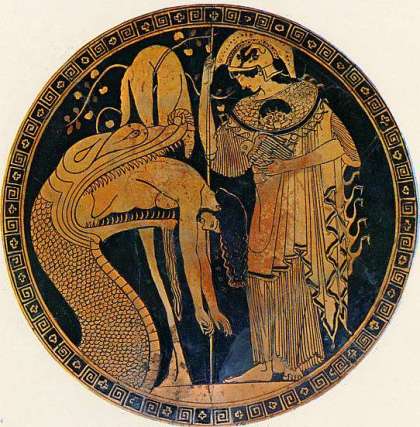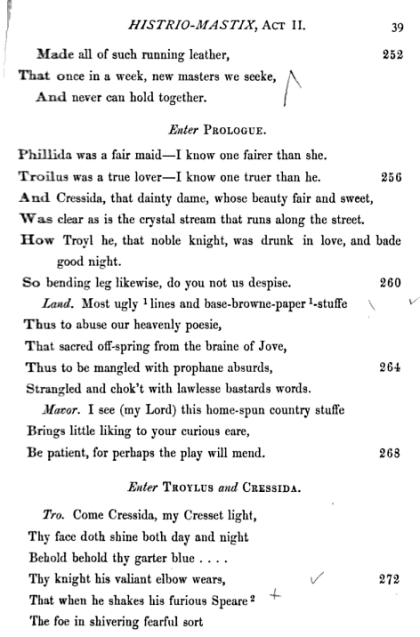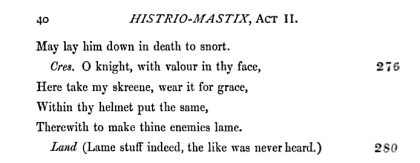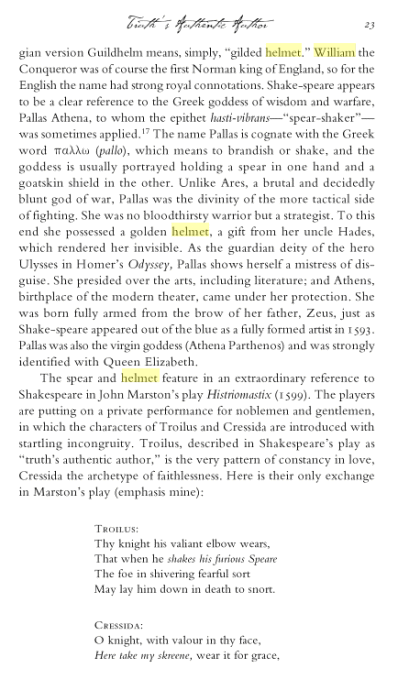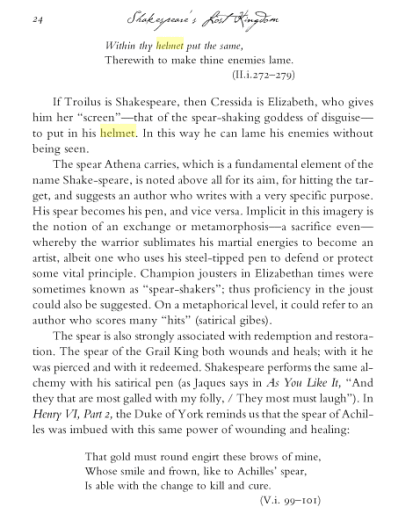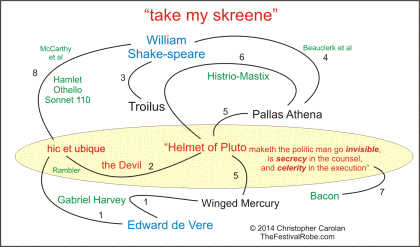The Invisible Man
Troilus & Cressida in Histrio-Mastix
The play Histrio-Mastix, dated to near 1599 and possibly by Marston contains a number of plays within plays. One of these is Troilus & Cressida. In this brief scene in which Sir Oliver Owlet’s players enact the work of the work of the poet, Post-Haste, Troilus “shakes his furious spear.” This is taken by many as an allusion to William Shakespeare. Yet despite this allusion, quite a few scholars, particularly those aligned with the tourist interests, consider the Troilus scene in Histrio-Mastix to be a satire on another version of Troilus written by Dekker and Chettle. there is concrete evidence for a Dekker and Chettle version of Troilus, unlike the Ur Hamlet, or Ur Macbeth of invented legend. My argument here is not about chronology. My interest is what the contents of the Troilus scene in Histrio-Masitx tells us about the authorship question. And especially to apply some of the enormous amounts of information Rambler has unearhed in his blog, Quake-speare Shorterly to this particular scene. Let’s examine this brief scene in Histrio-Mastix, contrast it with Shakespeare’s version, and perhaps delve a little deeper into who and what was being satirized and what information is revealed.
Pallas Athena with Helmet, Spear, & Owl. Douris Cup, Vatican, c 470 BCE.
The section in Act II where Sir Oliver Owlet’s players, performing the Troilus of the poet Post-Haste is brief and shown below. The play within a play is commented on by the Italian gentleman Landolphus.
click text to enlarge
click text to enlarge
Cressida is described as fair, and Troilus as true. These descriptions are both included in the orginal Chaucer version of Triolus, so they are not unique to Shakespeare. But look how Shakespeare describes Troilus’ true qualities. He goes over the top.
TROILUS
“Few words to fair faith: Troilus
shall be such to Cressid as what envy can say worst
shall be a mock for his truth, and what truth can
speak truest not truer than Troilus. ” III, ii.
That’s quite a few ‘trues’ placed in Troilus dialogue, echoes of the Vere’s motto, Vero nihil verius, ‘nothing truer than truth.’
Let’s get right to the satire…
And Cressida that dainty dame whose beauty fair and sweet
Was clear as is the crystal stream that ran along the street.
The gutters of Tudor London along the street were filthy, including human waste. Cressida is covered in proverbial sewage!
Shakespeare’s play has an exchange of a sleeve and a glove between Troilus and Cressida. Here’s the text.
CRESSIDA
“O, you shall be exposed, my lord, to dangers
As infinite as imminent! but I’ll be true.TROILUS
And I’ll grow friend with danger. Wear this sleeve.CRESSIDA
And you this glove. When shall I see you?TROILUS
I will corrupt the Grecian sentinels,
To give thee nightly visitation.
But yet be true.CRESSIDA
heavens! ‘be true’ again!” III. iv.
Scholars have compared the exchange of garter and screen in Histrio-Mastix to the above exchange in Shakespeare;s Troilus. But it’s not an exchange in Troilus. Clearly Cressida has given the blue garter to Troilus earlier, and he wears it. Now she’s giving him a ‘skreene’ to place in his helmet. The ‘blue garter’ alludes to the Order of the Garter. When the Queen invests those Knights in the order, they are given a blue garter. Only the Queen can admit members to the Order. Now, one could debate that if this is an authorship allusion, the inference is that Troilus is a member of the Order of the Garter. Vere was not a member, despite what would seem his inside tracking at attaining garter status given his high rank. The garter reference can be taken as biting satire, poking fun at that nobleman who was repeatedly denied the Order by portraying his hero Troilus as receiving that same honor from a Queen as fair as sewage. The important point I want to make is that the identification of Cressida with Queen Elizabeth is strong, as only she can award blue garters.
Now let us focus on the ‘skreene’ the queen figure gives to true Troilus. Here’s Charles Beauclerk’s commentary on the connection between the name William Shakespeare and Pallas Athena. This work is not all original to Beauclerk, though I haven’t seen the deconstruction of William as a reference to Pallas Athena’s helmet elsewhere. Beauclerk references the allusion in Histrio-Mastix as well.
click text to enlarge
click text to enlarge
click text to enlarge
Beauclerk identifies both Troilus’ shaking spear and the helmet with Pallas Athena’s spear and helmet, the latter given to her by Hades. But there’s more. The poet-author of Troilus in Histrio-Mastix is Post-Haste. Hasta is spear in Latin. The patron of the company if Sir Oliver Owlet. The owl is also one of Pallas Athena’s symbols. The Greek bowl at the top of the page shows Athena with spear, helmet and owl. The symbols of Athena pervade all levels of the acting company in Histrio, patron, poet and actor.
Let’s examine the ‘skreene’ that Cressida/Elizabeth gives to true Troilus in more detail.
OED skreene – Something interposed so as to conceal from view.
“Now neere enough: Your leauy Skreenes throw downe, And shew like those you are.” MacBeth
Athena’s helmet is also known as the cap of invisiblity, and the Helm of Hades, and in the Rennaissance as the Helmet of Pluto.
The cap of invisibility is linked with the god of the underworld – In the Renaissance, Erasmus, in Adages, links it with a figure of speech, depicting one who remains invisible.
From Erasmus, Adages 1550:
“Orel habet Galeam.
He has the helmet of Pluto, was used to be said of persons, who by base and insidious arts, incited others to acts of villany, without themselves appearing to be concerned in them. Those who wore the helmet of Pluto were said to be invisible, but to see every thing about them ; whence the adage.”
Francis Bacon gets more specific in his essay, Of Delays.
“For the helmet of Pluto, which maketh the politic man go invisible, is secrecy in the counsel and celerity in the execution. For when things are once come to the execution, there is no secrecy comparable to celerity; like the motion of a bullet in the air, which flieth so swift as it outruns the eye.”
Bacon describes the link between speed and invisibility that then modern man observed with firearms. If something moves fast enough, you can’t see it. Athena is not the only one who wore Hades’ helmet. Mercury and Perseus as well. Mercury wearing the Helmet of Pluto can’t be seen because he’s moving so fast. Now, we see some themes emerging here. One, the connection of the cap given to true Troilus with the underworld, and two the connection between speed and invisibility as bestowed by the cap of invisibility/helmet of Pluto.
Two frequent markers that Rambler has uncovered in allusions to Vere in works of the period are hic et ubique, which he connects with the devil here, and ‘haste’ which he connects with hasta, the Latin for spear. I think haste is also a reference to speed as an attribute of invisibility. Gabriel Harvey describes Vere as “Winged like Mercury” in the Speculum Tuscanismi? and as ‘hic et ubique’ in the same document. The speed and invisibilty bestowed by the helmet allows Mercury to be here and everywhere at once, and this ability is bestowed on Mercury by Hades/Pluto. In Histrio-Mastix Cressida/Elizabeth bestows the Helmet of Pluto on true Troilus.
Rambler has noted other connections between both Vere and Mercury and Shakspeare and Mercury.
“The stage direction that gets Eastward Ho (1604) underway has Quicksilver with a tennis racket “trussed” (!!) under his clothing; nobody plays tennis in the play. Quicksilver = Mercury = Hermes (Thomas Freeman, Epigram 92, 1614: “Shakespeare, that nimble Mercury thy braine / Lulls many hundred Argus-eyes asleepe …“). Rambler 24 Dec. 2013
The diagram below illustrates the Helmet of Pluto as the skreene placed by the Queen/Cressida between Vere and Shakespeare, granting him invisibility and secrecy in his theatrical pursuits, separate from his nobleman persona. We are reminded of Earl Lassinbergh the nobleman in Dr. Dodypoll who is an artist (under an assumed name) by day and an earl by night.
click illustration to enlarge
Executive Summary.
- Gabriel Harvey said of Vere; “hic et ubique apud nos volitantium” and “Winged like Mercury” – Speculum Tuscanismi?
- “hic et ubique” “here and everywhere” associates with either god, or the devil – see Rambler.
- Troilus & Cressida was authored by Shake-speare. Shakespeare’s version is satirized in Histrio-Mastix.
- Beauclerk and others have shown the William Shake-speare name as derived from the symbols of Pallas Athena
- The Helmet of Pluto, aka the cap of invisibility, was used by both Pallas Athena and Mercury (and Perseus) in mythology. It belonged to Pluto (Hades) the god of the underworld.
- The play, Histrio-Mastix ties in Pallas Athena through her symbols, including the Helmet of Pluto (my skreene), with a satirization of Shake-speare’s Troilus.
- Francis Bacon affirms the Helmet of Pluto as a proverbial device for hiding one’s true nature. The three characteristics of the Helmet of Pluto are invisibility, secrecy, and speediness (haste!).
- Multiple modern critics have examined Shake-speare’s use of hic et ubique as well as here and there, etc; McCarthy, Greenblatt, Potter, Rambler, etc.
Conclusion – the Helmet of Pluto is the screen of invisibility and secrecy bequeathed by the Queen (Cressida) to separate Vere from his public theater activities. We can connect Vere to the screen via Gabriel Harvey’s Speculum Tuscanismi? and its references to Winged Mrrcury and hic et ubique. And on the other side, we connect William Shakespeare to the screen via Histrio-Mastix’s satirization of Troilus & Cressida and it’s use of the symbols of Pallas Athena. Francis Bacon, in his essay “Of Delays” affirms the legitimacy of the Helmet of Pluto as a contemporary allusion for invisibility and secrecy in the Tudor/Jacobean period. Rambler has uncovered many instances of the word ‘haste’ attached to Vere allusions. The understanding of speediness as a link to invisibility, in addition to the pun on the Latin hasta, spear, solves the ‘why’ of this usage.
One other note. In the Histrio-Mastix section above, Landolphus takes offense at the satire of Troilus and Cressida. He names the playwright of the original Troilus being satirized as “Jove.” That fact will figure in the next installment of this blog.
Further reading. There’s a very good article by Henry Wood, Shakespeare Burlesqued that argues that all the plays within plays in Histrio-Mastix are parodies of Shakespeare plays.
October 5, 2014 1 Comment

